
Xing Lei, Vice President of ZEHO, delivered a speech at the 2021 CLA Youth Forum in Shenzhen on April 28. Chinese Society for Urban Studies Committee of Landscape Architecture (CLA) hosted the forum. The theme of Xing Lei's communication was Nature-based Solutions (NbS) - Thinking and Practice. ZEHO hopes to share our research and practical experience in Nature-based Solutions (NbS) in ecological environment with young people through this activity, to encourage young designers to take part in the beautiful land construction.

Xing Lei shares thoughts and practices on NbS

The communication is ongoing

Group photo of experts
01 - About NbS…
The concept of NbS has been developed since 1970s. After 50 years of worldwide practices, the concept and design approach of NbS have been introduced into China in recent years, and attracted everyone's resonance and attention.
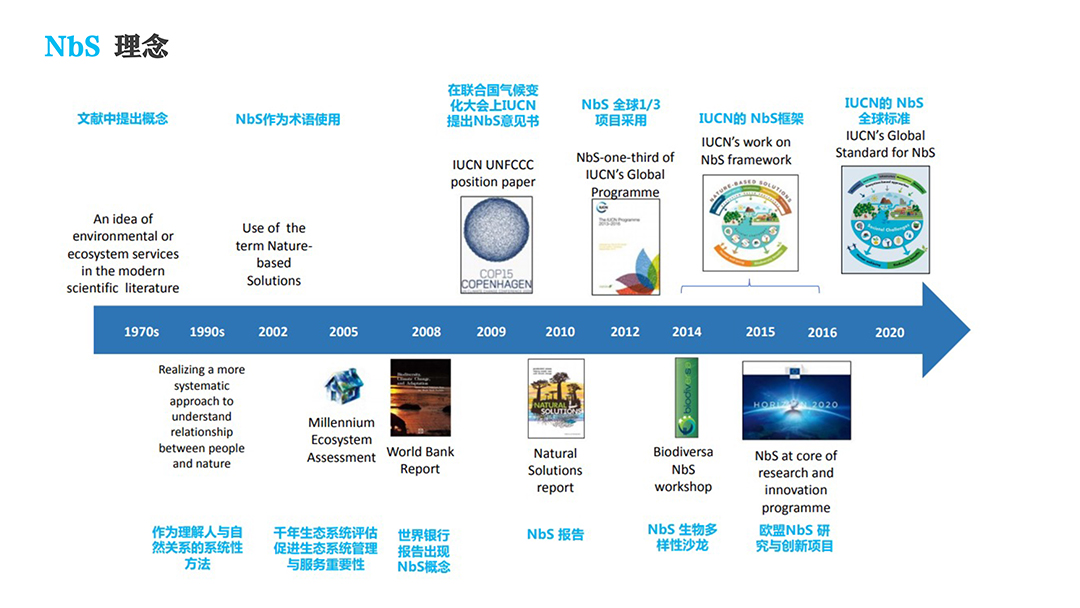
Development history of NbS
Definition of NbS
IUCN defines NbS as Nature-based Solutions are actions to protect, sustainably manage, and restore natural and modified ecosystems that address societal challenges effectively and adaptively, simultaneously providing human well-being and biodiversity benefits. President Xi said on Arbor Day that to build a beautiful China is to ensure the health of great rivers and mountains of the motherland, as well as the health of generations of Chinese people. In landscape practice, it is equally important to pay attention to biodiversity and ecosystem health as well as people's sense perception.
The EU definition of NbS is more suitable for practical application.
Since 2008, we have had periodic field trips to northern Europe. The sustainable development concept originated from northern Europe is to balance environmental, social and economic development and develop a resilient social ecosystem.
The practice and exploration of NbS should be suitable for China's national conditions. If we contrast the NbS definition of IUCN and EU from original intention, approach, aim and key information, we can infer a local explanation of NbS applicable in China: NbS are action plans inspired and supported by nature to protect, sustainably use and repair the natural or changed ecosystem, which have cost-effective, environmental, social and economic benefits, to effectively and adaptively cope with various challenges faced by today's society, improve biodiversity and support ecosystem services, and for the well-being of humankind.
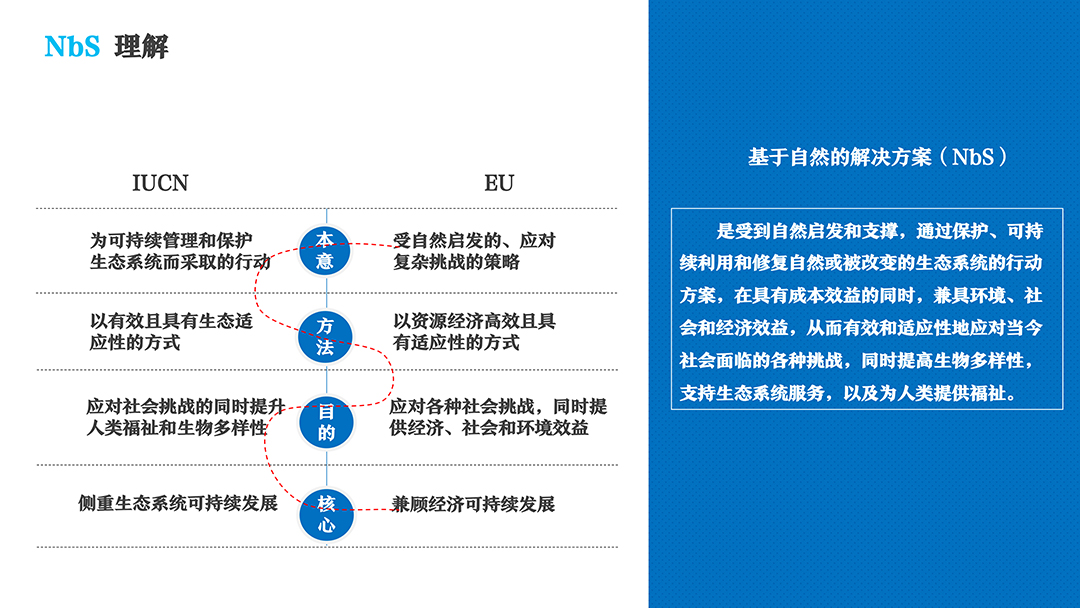
IUCN and EU's interpretation and understanding of NbS
There are five key methods for implementing NbS, including ecosystem preservation, ecological approach to specific problems, infrastructure construction, ecosystem restoration, and ecosystem-based management. These five aspects are the key to ensure the implementation of NbS.
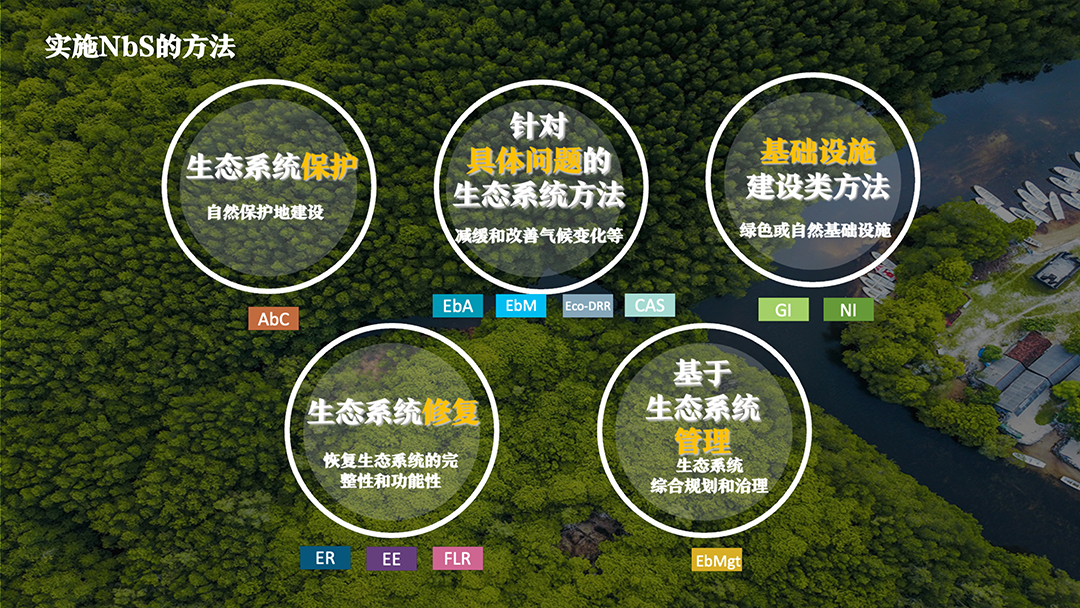
Implementation of NbS
Three thoughts on NbS
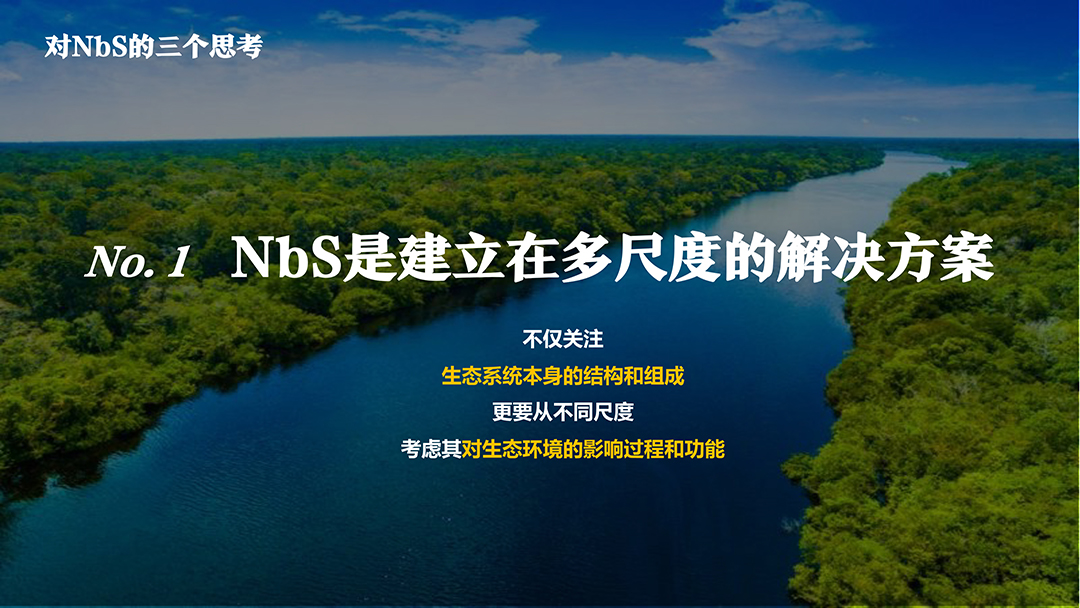
1. NbS are multi-scale solutions. For the future university education, we should help students to expand their cognition of other disciplines and integrate the knowledges based on professional education.
Some international projects reflect this characteristic of NbS. Take Edmonton's Green Network Strategy in Canada for example, the project considered not only the protection and restoration of ecological patches and ecological units but also the re-construction of a green network on the regional scale, and constantly improved the connection of the network which provided an important space for biodiversity protection.
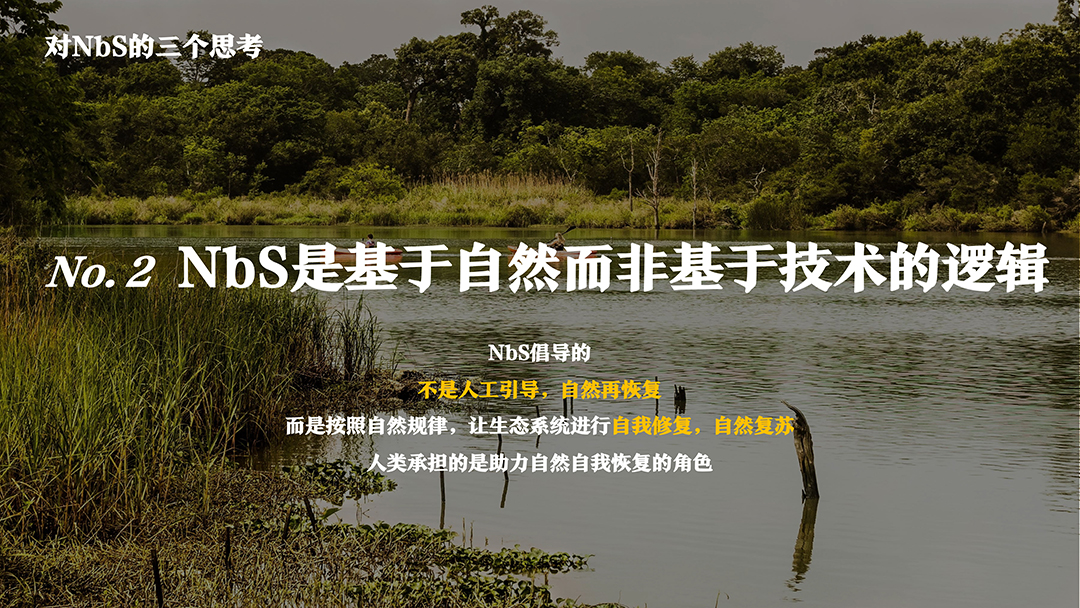
2. The logic of NbS is based on nature rather than technology. Now people can get in touch with all kinds of technologies through the Internet and other ways. I think the key to be competitiveness in the future is to apply technology to the appropriate place. For example, medicinal materials and medical devices are the same for doctors in a hospital, but some doctors can cure the patient, while others can't. So the most important thing is to analyze and consider the root of the problem.
The Florida Everglades in the U.S. were historically formed by the upstream lake water flowing into the Gulf of Florida. A variety of geomorphic structures such as rivers, lakes, ponds, swamps, tree islands, forests, bogs and mangrove swamps appeared. The Comprehensive Everglades Restoration Plan was passed by the Congress in 2000. The plan requires that the restoration should imitate the natural process and let the river return to nature. By removing the roads in the Everglades, the canalized river was restored to a natural meandering river, letting nature takes its course and restoring the Everglades ecosystem.
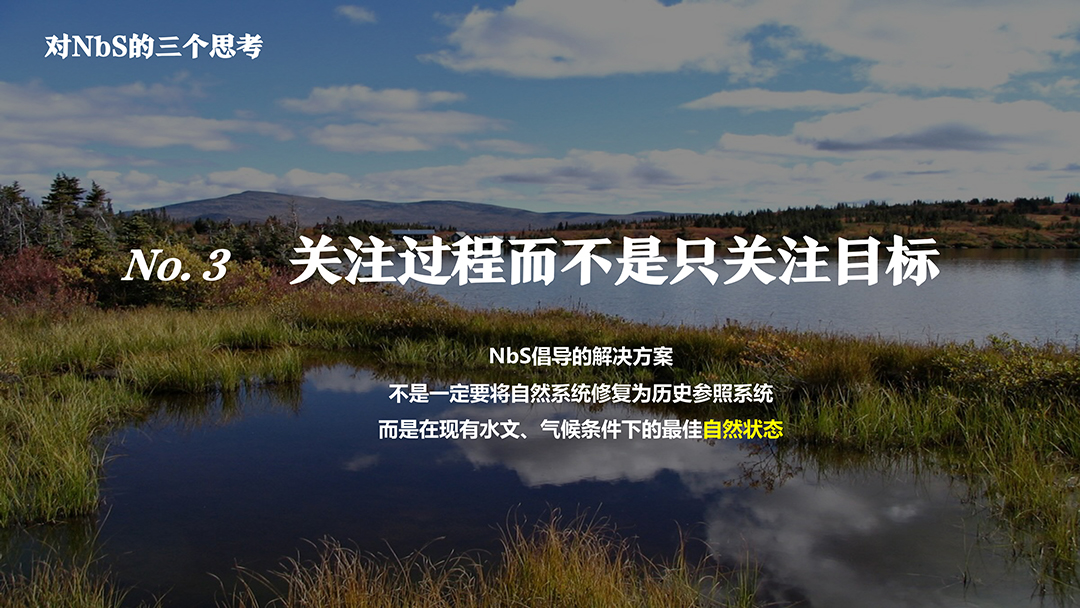
3. NbS focuse on the process, not just the objective.
The Houston Arboretum & Nature Center in Texas was in good condition in the 1950s. However, the ecological condition was seriously damaged due to the extreme climate and invasive species in recent years. 48% of the tree species in the forest area were threatened. With the increasing demand for natural education, the site restoration goal can no longer be to restore to the original condition, but should be combined with the changes of climate, hydrology, soil and other conditions now and in the future, and consider more appropriate plant communities to restore the environment. According to the research, 49% of the site terrain features were suitable for grassland, while the grassland only accounted for 2% before the restoration. Therefore, the project aim was optimized. The project increased the grassland area in the forest, to make the restored forest landscape more flexible to cope with future environmental changes. It is very important for NbS to deal with the biological crisis and build a more resilient and sustainable ecosystem process.
NbS in China
China has made significant achievements in the localization of NbS. In China's new era of ecological civilization, the concept of NbS is being implemented and practiced in the territorial spatial planning, the protection and restoration of ecosystems, and the overall planning of major national ecosystem protection and restoration projects. The applied space includes integrating permanent basic farmland, nature reserve, general ecological space in urban construction area, other ecological space and general agricultural space.
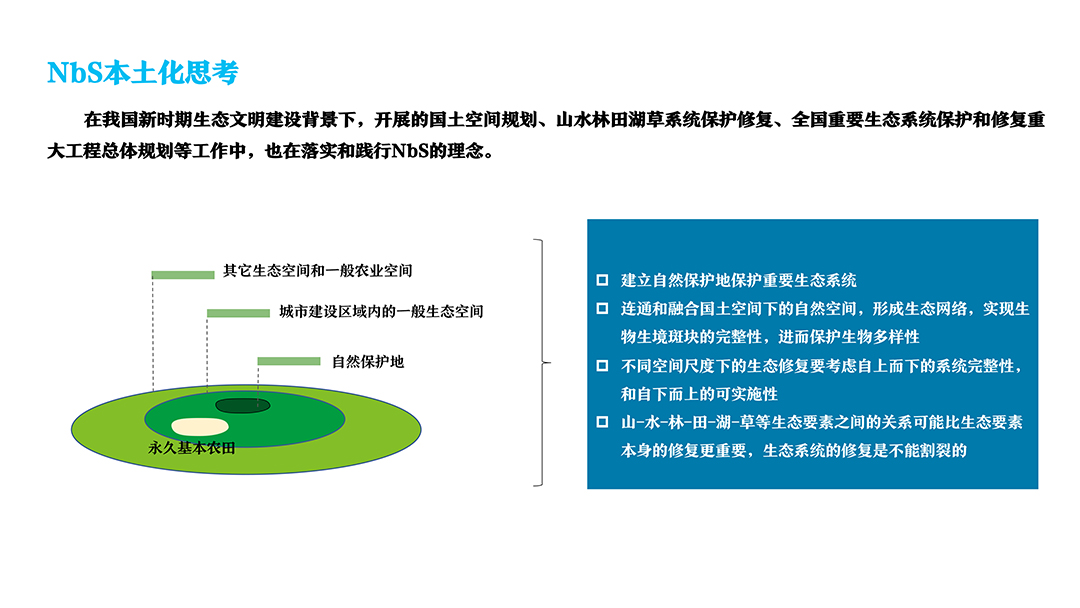
Thoughts on the localization of NbS
02 - ZEHO’Practice on NbS
We will share project experience from three aspects: regional / watershed scale planning, ecosystem scale design and site scale implementation, including blue-green ecological network, ecosystem integrity, and natural and green infrastructure.
Regional / watershed scale
In terms of regional / basin scale planning, we need to solve environmental problems, adapt to natural changes and integrate regional development. From the macro point of view, it is necessary to build ecological function network, identify and decompose the subsystems or protection and restoration units of each function network. From the landscape perspective, ecological restorationrequires designers to integrate their working methods and abilities.
For example, in the Blue-green Ecosystem Planning Project in Hengyang City, Hunan Province, we identified eight problems existing in the site from the aspects of urban construction space, agricultural production and ecological space. In view of the problems, we have managed, adjusted, restored, connected, protected, linked, stitched and activated the site through pollution purification, rainwater storage, ecological protection and restoration, and urban and natural vitality. And hope to form a blue-green ecosystem network with the support of big data. Through the integration and connection of ecological space, a resilient and sustainable blue-green ecosystem will be constructed, including water system, farmland, biological protection, functional green space and intelligent monitoring, which will be connected with urban digital integration in the future. Many local governments are developing Intelligent Operations Center (IOC), and the digital path of future cities will be clearer.
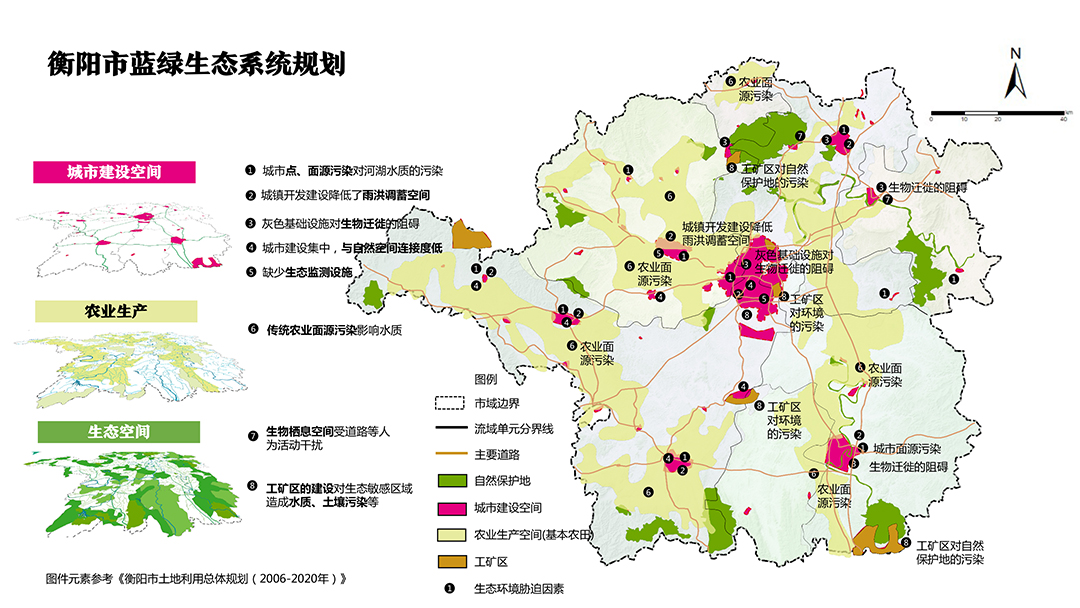
Blue-green Ecosystem Planning in Hengyang City
Ecosystem scale
From ecosystem design perspective, we should ensure the integrity of ecosystem, the continuity of structure and function.
The Ecological Restoration Design of Erhai Lake Riparian Buffer Zone in Dali aims to restore the competitive natural habitat and realize the healthy and sustainable development of the lakeside buffer zone. We used the Ecological Restoration Wheel as the tool, and took the problems as the guidance, to solve the key issues of the site, including the dry wet ratio, the habitat richness, and the types of plant community. The buffer zone is only 100 meters wide. We have redesigned the entire 129 kilometers around the Erhai Lake. The broken patches in the demonstration section were transformed into ecological bases after the restoration, including ecological dense forest, under forest wetland, meadow wetland, estuary wetland, stream wetland, ecological grassland, sparse forest grassland, ecological pond, lakeside forest land, and lakeside beach, forming a low-interference ecological corridor. Finally, we evaluated the repair effect through project tracking and some data analysis.
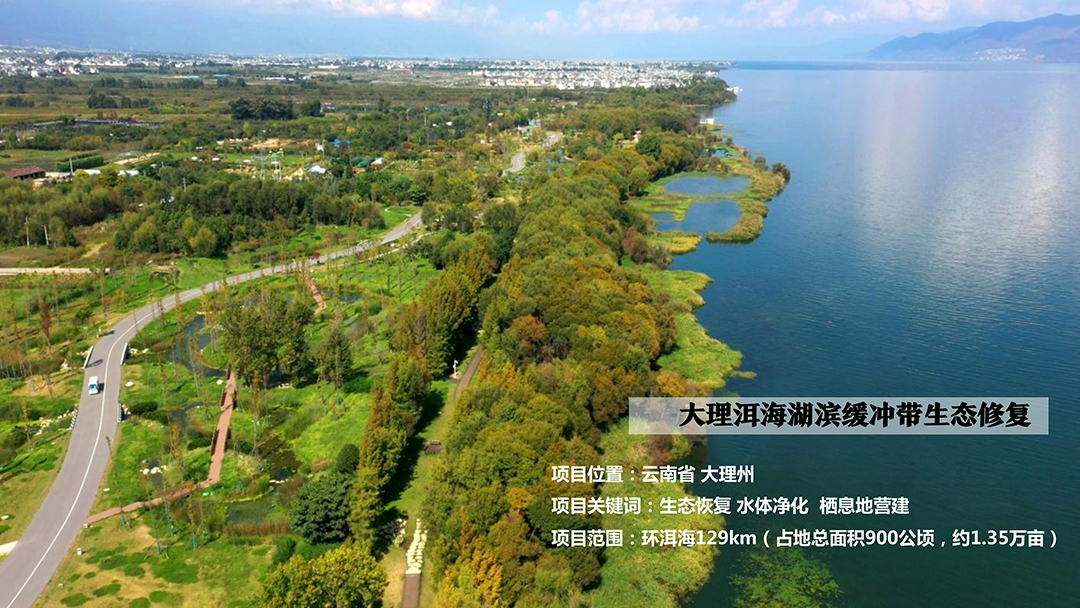
Ecological Restoration Design of Erhai Lake Riparian Buffer Zone
Site scale
From the implementation scale of site ecological engineering, we should pay more attention to the adaptability and sustainable management of natural environment. ZEHO attaches great importance to the absorption and learning of international concepts and constantly establishes and improves the technical system to support the implementation. However, in addition to the concept and technology system, we should also implement the project through ecological engineering, so as to truly realize the design concept and technology.
In the Ecological Shoreline Design of Lingshan Island Cape in Nansha, Guangzhou, we have designed the natural restoration of the ecological shoreline. The first strategy we adopted is to use thetwo-dimensional hydrodynamic water quality mathematical model to simulate the changes of flow field and pollutant concentration in the water of Lingshan Island Cape, which can be used as the support data for the design of river ecological space. After investigation, we reshaped nature and provided diverse habitats for living things. We have considered providing a stable living environment for plants, creating a diverse water shoreline, creating a diverse habitat, providing a habitat for birds, fish and benthos, and improving the biodiversity. We utilized local materials, wasted plants and ecological methods to reinforce slope and protect bank to ensure water safety.

Ecological Shoreline Design of Lingshan Island Cape in Nansha, Guangzhou
03 - Prospect of NbS in the New Era
We hope young designers will pay more attention to climate change in the future. From climate change to climate crisis, implementing NbS will be more important. International documents, including the Paris Agreement and the Nature-based Solutions in Nationally Determined Contributions, are calling on all countries worldwide to mitigate climate change by carbon reduction.
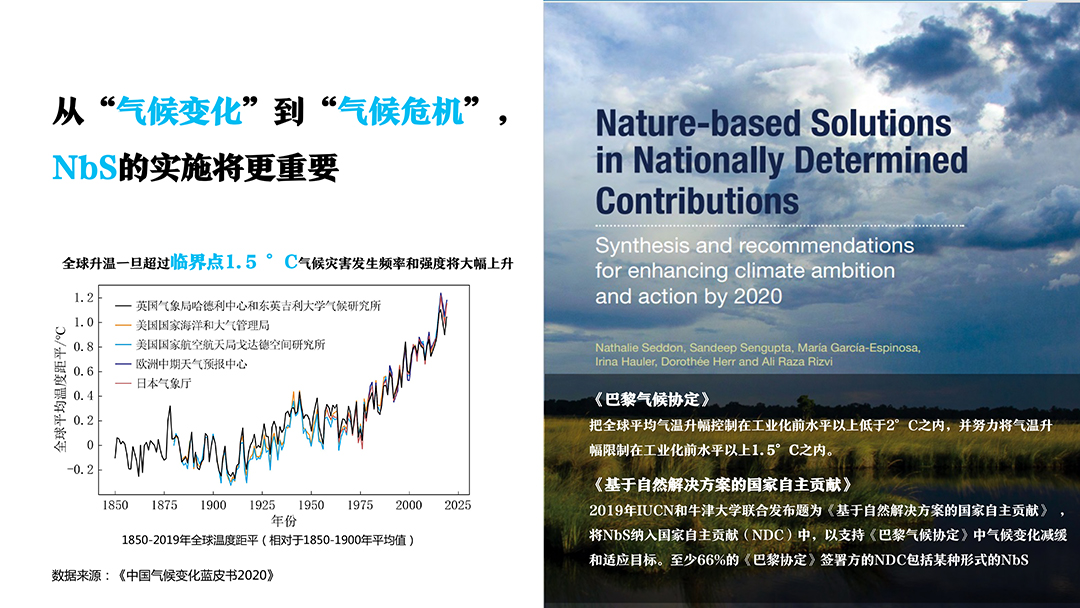
The implementation of NbS is of great significance for mitigating climate change
However, NbS is not omnipotent, there are still many problems in mitigation and response to climate change. At present, there is a lack of quantifiable objectives for NbS, such as how to evaluate the ecosystem health after the project complete. In the future, we will work with environmental engineering and ecological scientists to study how to quantify the NbS targets and connect the data to the Intelligent Operations Center of each city. Another problem is NbS only pays attention to forest ecosystems but ignores other ecosystems with higher carbon sequestration capacity. To achieve the goal of carbon peak and carbon neutralization, implementing NbS should be more scientific and systematic.
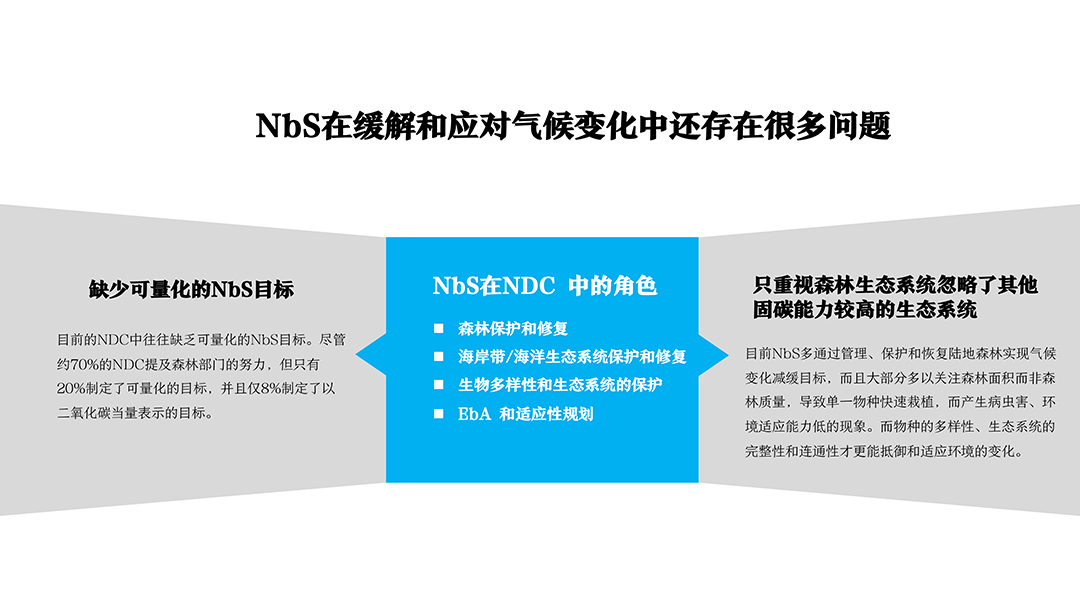
We hope that through the continuous collection of data in the future, we can form a scientific and detailed data stream, which can provide strong technical support for the NbS objectives quantification, realize the connection between NbS and science and technology in the ecological civilization new era, and carry out whole process digital dynamic ecosystem assessment.
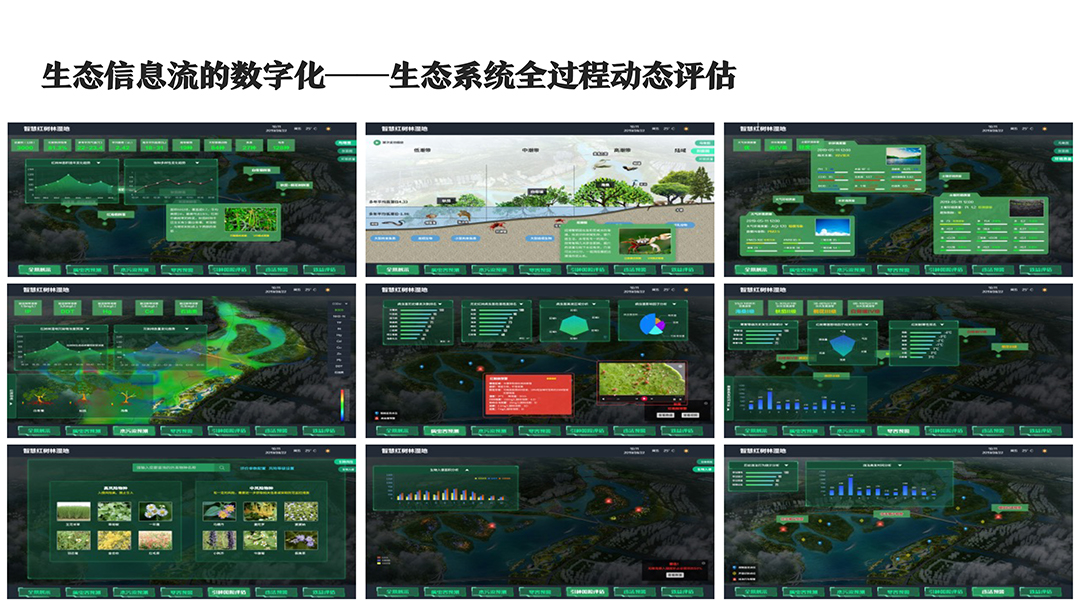
Digitalization of ecological data stream
Under the symbiotic chain of human and nature, there is still a long way to go to adapt to future climate change and practice NbS. ZEHO will make unremitting efforts to realize the sustainable development of human and nature with intelligent ecology.
ZEHO ECO: Harmonizing Tradition and Innovation in Ancient Architecture Exhibition Parks
ZEHO ECO was invited to speak at the 2023 Carbon Neutrality, Zero Carbon China Summit
ZEHO shared knowledge in the 10th National Landscape Ecology Annual Meeting and International Academic Seminar
2020-12-30